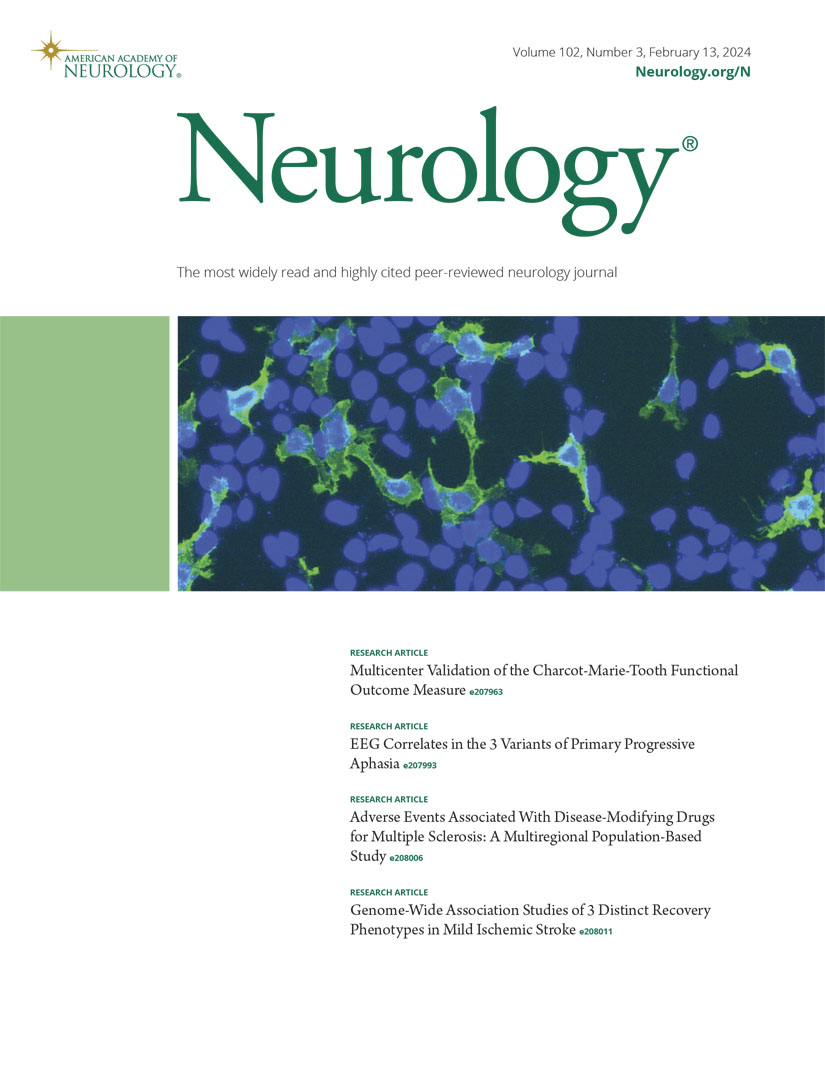脑衰弱对急性缺血性脑卒中取栓患者临床表现及神经功能恢复的影响。
IF 7.7
1区 医学
Q1 CLINICAL NEUROLOGY
引用次数: 0
摘要
背景与目的脑衰弱损害脑功能障碍的补偿能力,并与脑卒中后较差的预后有关。卒中发病时的严重程度是急性缺血性卒中预后的关键决定因素。本研究旨在探讨脑衰弱对急性缺血性卒中(AIS)患者血管内取栓(EVT)初始卒中严重程度和恢复的影响。方法我们对ESCAPE-NA1随机对照试验进行了事后分析,该试验研究了神经保护剂nerinetide在接受EVT的AIS患者中的疗效和安全性。脑脆弱标志物(皮质萎缩、皮质下萎缩、白质高信号、慢性梗死)从基线非对比CT扫描进行视觉评估。我们使用多变量分位数回归探讨了这些指标与入院时卒中严重程度(美国国立卫生研究院卒中量表[NIHSS]评分)之间的关系。我们还使用重复测量分析评估了90天内NIHSS的轨迹。对模型进行相关协变量调整。结果1102名参与者(平均年龄69.5岁;49.7%女性),在调整混杂因素后,皮质萎缩患者和慢性梗死患者的NIHSS基线评分高于无皮质萎缩或慢性梗死患者(GCA1 vs GCA0的调整差值= 1.25分[95% CI 0.18-2.31], p = 0.021;存在慢性梗死的校正差异= 1.27点[95% CI 0.007-2.53, p = 0.049])。皮层下萎缩、白质高强度负担、脑凹窝和整体脑虚弱与NIHSS评分无关。重复测量分析显示,在整个90天的随访期间,急性期后,脑衰弱个体的NIHSS评分始终高于无脑衰弱个体(30天的NIHSS评分,调整后的总脑衰弱评分差异为1 vs 0 = 1.16分[95% CI 0.35-1.96], p = 0.01;脑衰弱评分2/3 vs 0 = 0.98 [95% CI 0.08-1.88], p = 0.03;90天NIHSS评分(脑衰弱评分1 vs 0的调整差异= 0.97 [95% CI 0.19-1.75], p = 0.01;脑衰弱评分2/3 vs 0 = 0.85 [95% CI -0.01 ~ -1.71], p = 0.05)。本研究强调了脑脆弱性与AIS患者接受EVT的临床表现和恢复轨迹的关联。具体而言,皮质萎缩与基线卒中严重程度独立相关,脑虚弱的总负担与NIHSS恢复轨迹独立相关。结果强调了在急性卒中管理和预后中考虑脑脆弱性的重要性。本文章由计算机程序翻译,如有差异,请以英文原文为准。
Impact of Brain Frailty on Clinical Presentation and Neurologic Recovery in Acute Ischemic Stroke Patients Undergoing Thrombectomy.
BACKGROUND AND OBJECTIVES
Brain frailty impairs the ability to compensate for brain dysfunction and is linked to worse outcomes after stroke. Stroke severity at presentation is a key determinant of outcomes in acute ischemic stroke. This study aimed to examine the impact of brain frailty on initial stroke severity and recovery in acute ischemic stroke (AIS) patients undergoing endovascular thrombectomy (EVT).
METHODS
We conducted a post hoc analysis of the ESCAPE-NA1 randomized-controlled trial that investigated the efficacy and safety of the neuroprotectant nerinetide in patients with AIS who received EVT. Brain frailty markers (cortical atrophy, subcortical atrophy, white matter hyperintensities, chronic infarcts) were visually assessed from baseline noncontrast CT scans. We explored the association between these markers and admission stroke severity (National Institutes of Health Stroke Scale [NIHSS] score) using multivariable quantile regression. We also assessed the NIHSS trajectory over 90 days using repeated-measures analysis. Models were adjusted for relevant covariates.
RESULTS
Among 1,102 participants (mean age 69.5 years; 49.7% female), NIHSS scores at baseline were higher in patients with cortical atrophy and those with chronic infarcts compared with patients having no cortical atrophy or chronic infarcts after adjusting for confounders (adjusted difference for GCA1 vs GCA0 = 1.25 points [95% CI 0.18-2.31], p = 0.021; adjusted difference for presence of chronic infarcts = 1.27 points [95% CI 0.007-2.53, p = 0.049]). Subcortical atrophy, white matter hyperintensity burden, lacunes, and overall brain frailty were not associated with NIHSS scores at presentation. A repeated-measures analysis showed consistent higher NIHSS scores in individuals with brain frailty compared with those without, after the acute phase throughout the 90-day follow-up period (NIHSS score at 30 days, adjusted difference for total brain frailty score 1 vs 0 = 1.16 points [95% CI 0.35-1.96], p = 0.01; brain frailty score 2/3 vs 0 = 0.98 [95% CI 0.08-1.88], p = 0.03; NIHSS score at 90 days (adjusted difference for brain frailty score 1 vs 0 = 0.97 [95% CI 0.19-1.75], p = 0.01; brain frailty score 2/3 vs 0 = 0.85 [95% CI -0.01 to -1.71], p = 0.05).
DISCUSSION
This study highlights the association of brain frailty with the clinical presentation and recovery trajectory of patients with AIS undergoing EVT. Specifically, cortical atrophy was independently associated with baseline stroke severity, and the total burden of brain frailty was independently associated with NIHSS recovery trajectories. The results emphasize the importance of considering brain frailty in acute stroke management and prognostication.
求助全文
通过发布文献求助,成功后即可免费获取论文全文。
去求助
来源期刊

Neurology
医学-临床神经学
CiteScore
12.20
自引率
4.00%
发文量
1973
审稿时长
2-3 weeks
期刊介绍:
Neurology, the official journal of the American Academy of Neurology, aspires to be the premier peer-reviewed journal for clinical neurology research. Its mission is to publish exceptional peer-reviewed original research articles, editorials, and reviews to improve patient care, education, clinical research, and professionalism in neurology.
As the leading clinical neurology journal worldwide, Neurology targets physicians specializing in nervous system diseases and conditions. It aims to advance the field by presenting new basic and clinical research that influences neurological practice. The journal is a leading source of cutting-edge, peer-reviewed information for the neurology community worldwide. Editorial content includes Research, Clinical/Scientific Notes, Views, Historical Neurology, NeuroImages, Humanities, Letters, and position papers from the American Academy of Neurology. The online version is considered the definitive version, encompassing all available content.
Neurology is indexed in prestigious databases such as MEDLINE/PubMed, Embase, Scopus, Biological Abstracts®, PsycINFO®, Current Contents®, Web of Science®, CrossRef, and Google Scholar.
 求助内容:
求助内容: 应助结果提醒方式:
应助结果提醒方式:


